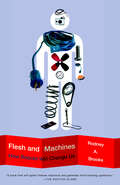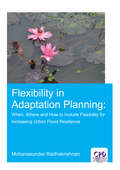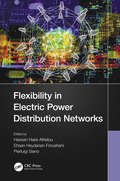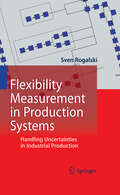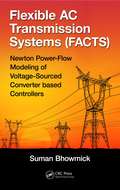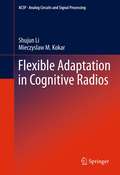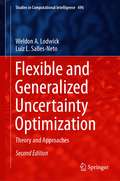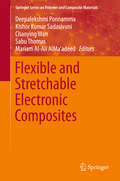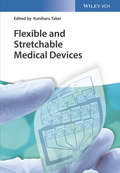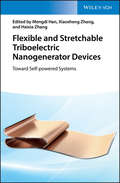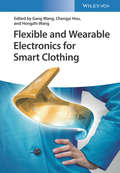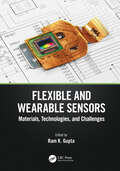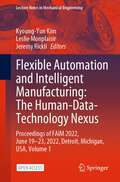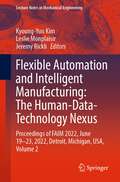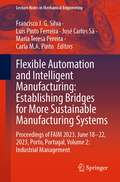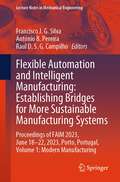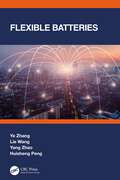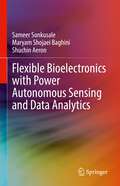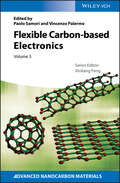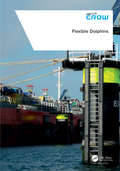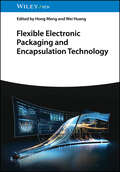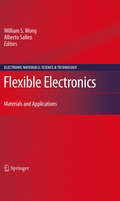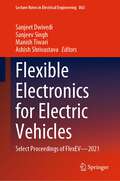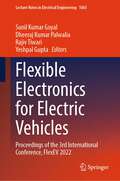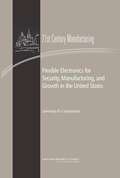- Table View
- List View
Flesh and Machines: How Robots Will Change Us
by Rodney A. BrooksAre we really on the brink of having robots to mop our floors, do our dishes, mow our lawns, and clean our windows? And are researchers that close to creating robots that can think, feel, repair themselves, and even reproduce? Rodney A. Brooks, director of the MIT Artificial Intelligence Laboratory believes we are. In this lucid and accessible book, Brooks vividly depicts the history of robots and explores the ever-changing relationships between humans and their technological brethren, speculating on the growing role that robots will play in our existence. Knowing the moral battle likely to ensue, he posits a clear philosophical argument as to why we should not fear that change. What results is a fascinating book that offers a deeper understanding of who we are and how we can control what we will become.
Flexibility in Adaptation Planning: When, Where and How to Include Flexibility for Increasing Urban Flood Resilience (IHE Delft PhD Thesis Series)
by Mohanasundar RadhakrishnanThe magnitude and urgency of the need to adapt to climate change is such that addressing it has been taken up by the United Nations as one of the sustainable development goals - Goal 13 (SDG13) in 2015. SDG13 emphasises the need to strengthen resilience and adaptive capacity to climate related hazards and natural disasters. Coping with urban floods is one of the major needs of climate adaptation, where integration of climate change responses into flood risk management policies, strategies and planning at international, national, regional and local levels is now the norm. However, much of this integration lacks effectiveness or real commitment from stakeholders involved in adaptation planning and implementation. Hence this research has focused on integrating flexibility based adaptation responses into an urban flood risk management context. The research has synthesised flexible adaptation practices from several disciplines including information technology, automobile and aerospace manufacturing. The outcomes of the research are brought together in a framework for structuring local adaptation responses and an adaptation planning process based on flexibility concepts. The outcomes provide a way to assist with the identification of the appropriate nature and type of flexibility required; where flexibility can best be incorporated; and when is the most appropriate time to implement the flexible adaptation responses in the context of urban flooding.
Flexibility in Electric Power Distribution Networks
by Hassan Haes Alhelou Ehsan Heydarian-Forushani Pierluigi SianoHigh penetration of renewable energy sources (RESs) imposes several techno-economic challenges to distribution system operators (DSOs) due to their variability in power generation and hence, increases the need for additional operational flexibility. Operational flexibility aims at securely covering the possible variations at least cost using emerging flexible alternatives or designing novel local market mechanisms to incentivize flexibility providers. In such a situation, the DSOs can use the potential of flexible options such as Energy Storages (ESs), Demand Response (DR), Plug-in Electric Vehicles (PEVs) or on-site fast run generators. However, each of the mentioned flexible resources has its own specific characteristics and requirements that should be taken into account and this raises the problem complexity. Optimal network reconfiguration schemes are also the other solution for increasing power system flexibility at distribution level. There is a great research gap related to renewable-based distribution network planning with flexibility point of view. Therefore, this book aims to discuss the additional flexibility needs introduced by RESs and describe general approaches to analyze the need for and provision of additional flexibility in future distribution networks at both planning and operational time frames. This book successfully suggests new solutions and techniques to increase the flexibility in distribution systems. This book also highlights the needs for moving towards smart distribution grids in order to enhance the flexibility in modern and future power systems.
Flexibility Measurement in Production Systems
by Sven RogalskiThe requirements for production systems are constantly changing as a result of changing competitive conditions. This poses a challenge for manufacturers in the various branches of industry and creates an ever-increasing need for flexibility. With this as a background, this book explores the current developments and trends as well as their impact on today's production systems. It also compares known strategies, concepts and methods used to achieve production flexibility. Similarly, the practical knowledge and current research will be drawn upon and subjected to a sound scientific analysis, through which the technical and organizational flexibility ranges can be measured in their application in a production system. The convenience and usefulness of this concept for manufacturers is substantiated by its implementation in a software tool called ecoFLEX and its practical application, based on extensive examples. This illustrates how flexibility flaws can be quickly identified, classified and properly disposed of using ecoFLEX. This tool helps to close the gap between ERP / PPS systems and digital factory planning tools.
Flexible AC Transmission Systems (FACTS): Newton Power-Flow Modeling of Voltage-Sourced Converter-Based Controllers
by Suman BhowmickFlexible AC Transmission Systems (FACTS): Newton Power-Flow Modeling of Voltage-Sourced Converter-Based Controllers introduces different voltage-sourced converter (VSC)-based FACTS controllers and VSC-based high-voltage direct current (VSC-HVDC) systems and their working principles, explaining how FACTS controllers exchange real and reactive power with systems. Subsequently, the book: Describes the Newton–Raphson method and its application for solving the power-flow problem Presents the Newton power-flow modeling of the static synchronous series compensator (SSSC), unified power-flow controller (UPFC), interline power-flow controller (IPFC), generalized unified power-flow controller (GUPFC), and static synchronous compensator (STATCOM), accommodating the practical device constraint limits (because of the unique modeling strategy, the existing Newton power-flow codes can be reused) Develops a unified Newton power-flow model of AC systems incorporating multiterminal VSC-HVDC systems with pulse-width modulation (PWM) control schemes, directly yielding the VSC modulation indices from the power-flow solution Provides numerous case studies for validation of Newton power-flow models, elaborating on the occurrences and checking of unrealistic power-flow solutions in isolated cases Includes detailed derivations of all the difficult formulae as well as solved problems on typical VSC-based FACTS controllers Flexible AC Transmission Systems (FACTS): Newton Power-Flow Modeling of Voltage-Sourced Converter-Based Controllers assumes at least an undergraduate-level understanding of engineering mathematics, network analysis, electrical machines, electrical power systems, and power electronics. Thus, the book provides a valuable reference for practitioners as well as senior-undergraduate and graduate students in electrical engineering and electrical power systems.
Flexible Adaptation in Cognitive Radios
by Miecyslaw Kokar Shujun LiThis book provides an introduction to software-defined radio and cognitive radio, along with methodologies for applying knowledge representation, semantic web, logic reasoning and artificial intelligence to cognitive radio, enabling autonomous adaptation and flexible signaling. Readers from the wireless communications and software-defined radio communities will use this book as a reference to extend software-defined radio to cognitive radio, using the semantic technology described.
Flexible and Generalized Uncertainty Optimization: Theory and Approaches (Studies in Computational Intelligence #696)
by Weldon A. Lodwick Luiz L. Salles-NetoThis book presents the theory and methods of flexible and generalized uncertainty optimization. Particularly, it describes the theory of generalized uncertainty in the context of optimization modeling. The book starts with an overview of flexible and generalized uncertainty optimization. It covers uncertainties that are both associated with lack of information and are more general than stochastic theory, where well-defined distributions are assumed. Starting from families of distributions that are enclosed by upper and lower functions, the book presents construction methods for obtaining flexible and generalized uncertainty input data that can be used in a flexible and generalized uncertainty optimization model. It then describes the development of the associated optimization model in detail. Written for graduate students and professionals in the broad field of optimization and operations research, this second edition has been revised and extended to include more worked examples and a section on interval multi-objective mini-max regret theory along with its solution method.
Flexible and Stretchable Electronic Composites
by Deepalekshmi Ponnamma Kishor Kumar Sadasivuni Chaoying Wan Sabu Thomas Mariam Al-Ali AlMa'adeedThis book is the first comprehensive collection of electronic aspects of different kinds of elastomer composites, including combinations of synthetic, natural and thermoplastic elastomers with different conducting fillers like metal nanoparticles, carbon nanotubes, or graphenes, and many more. It covers elastomer composites, which are useful in electronic applications, including chemical and physical as well as material science aspects. The presented elastomer composites have great potential for solving emerging new material application requirements, for example as flexible and wearable electronics. The book is structured and organized by the rubber/elastomer type: each chapter describes a different elastomer matrix and its composites. While introducing to important fundamentals, it is application-oriented, discussing the current issues and challenges in the field of elastomer composites. This book will thus appeal to researchers and scientists, to engineers and technologists, but also to graduate students, working on elastomer composites, or on electronics engineering with the composites, providing the readers with a sound introduction to the field and solutions to both fundamental and applied problems.
Flexible and Stretchable Medical Devices
by Kuniharu TakeiThe book introduces flexible and stretchable wearable electronic systems and covers in detail the technologies and materials required for healthcare and medical applications. A team of excellent authors gives an overview of currently available flexible devices and thoroughly describes their physical mechanisms that enable sensing human conditions. In dedicated chapters, crucial components needed to realize flexible and wearable devices are discussed which include transistors and sensors and deal with memory, data handling and display. Additionally, suitable power sources based on photovoltaics, thermoelectric energy and supercapacitors are reviewed. A special chapter treats implantable flexible sensors for neural recording. The book editor concludes with a perspective on this rapidly developing field which is expected to have a great impact on healthcare in the 21st century.
Flexible and Stretchable Triboelectric Nanogenerator Devices: Toward Self-powered Systems
by Mengdi Han Xiaosheng Zhang Haixia ZhangThe book starts with the fundamentals of triboelectric nanogenerators (TENGs), and continues through to fabrication technologies to achieve flexible and stretchable. Then self-powered flexible microsystems are introduced and application examples are presented, including TENG-based active sensors, TENG-powered actuators, artificial intelligence and integrated systems.
Flexible and Wearable Electronics for Smart Clothing
by Gang WangProvides the state-of-the-art on wearable technology for smart clothing The book gives a coherent overview of recent development on flexible electronics for smart clothing with emphasis on wearability and durability of the materials and devices. It offers detailed information on the basic functional components of the flexible and wearable electronics including sensing, systems-on-a-chip, interacting, and energy, as well as the integrating and connecting of electronics into textile form. It also provides insights into the compatibility and integration of functional materials, electronics, and the clothing technology. Flexible and Wearable Electronics for Smart Clothing offers comprehensive coverage of the technology in four parts. The first part discusses wearable organic nano-sensors, stimuli-responsive electronic skins, and flexible thermoelectrics and thermoelectric textiles. The next part examines textile triboelectric nanogenerators for energy harvesting, flexible and wearable solar cells and supercapacitors, and flexible and wearable lithium-ion batteries. Thermal and humid management for next-generation textiles, functionalization of fiber materials for washable smart wearable textiles, and flexible microfluidics for wearable electronics are covered in the next section. The last part introduces readers to piezoelectric materials and devices based flexible bio-integrated electronics, printed electronics for smart clothes, and the materials and processes for stretchable and wearable e-textile devices. -Presents the most recent developments in wearable technology such as wearable nanosensors, logic circuit, artificial intelligence, energy harvesting, and wireless communication -Covers the flexible and wearable electronics as essential functional components for smart clothing from sensing, systems-on-a-chip, interacting, energy to the integrating and connecting of electronics -Of high interest to a large and interdisciplinary target group, including materials scientists, textile chemists, and electronic engineers in academia and industry Flexible and Wearable Electronics for Smart Clothing will appeal to materials scientists, textile industry professionals, textile engineers, electronics engineers, and sensor developers.
Flexible and Wearable Sensors: Materials, Technologies, and Challenges
by Ram K. GuptaWith rapid technological developments and lifestyle advancements, electronic sensors are being seamlessly integrated into many devices. This comprehensive handbook explores current, state-of-the-art developments in flexible and wearable sensor technology and its future challenges. Numerous recent efforts have improved the sensing capability and functionality of flexible and wearable sensors. However, there are still many challenges in making them super-smart by incorporating features such as self-power, self-healing, and multifunctionality. These features can be developed with the use of multifunctional nanostructured materials, unique architectural designs, and other advanced technologies. This book provides details about the recent advancements, materials, and technologies used for flexible and wearable sensors. Its wide range of topics addresses the fundamentals of flexible and wearable sensors, their working principles, and their advanced applications. This handbook provides new directions to scientists, researchers, and students to better understand the principles, technologies, and applications of sensors in healthcare, energy, and the environment.
Flexible Automation and Intelligent Manufacturing: Proceedings of FAIM 2022, June 19–23, 2022, Detroit, Michigan, USA (Lecture Notes in Mechanical Engineering)
by Kyoung-Yun Kim Leslie Monplaisir Jeremy RickliThis is an open access book. It gathers the first volume of the proceedings of the 31st edition of the International Conference on Flexible Automation and Intelligent Manufacturing, FAIM 2022, held on June 19 – 23, 2022, in Detroit, Michigan, USA. Covering four thematic areas including Manufacturing Processes, Machine Tools, Manufacturing Systems, and Enabling Technologies, it reports on advanced manufacturing processes, and innovative materials for 3D printing, applications of machine learning, artificial intelligence and mixed reality in various production sectors, as well as important issues in human-robot collaboration, including methods for improving safety. Contributions also cover strategies to improve quality control, supply chain management and training in the manufacturing industry, and methods supporting circular supply chain and sustainable manufacturing. All in all, this book provides academicians, engineers and professionals with extensive information on both scientific and industrial advances in the converging fields of manufacturing, production, and automation.
Flexible Automation and Intelligent Manufacturing: Proceedings of FAIM 2022, June 19–23, 2022, Detroit, Michigan, USA, Volume 2 (Lecture Notes in Mechanical Engineering)
by Kyoung-Yun Kim Leslie Monplaisir Jeremy RickliThis book gathers the second volume of the proceedings of the 31st edition of the International Conference on Flexible Automation and Intelligent Manufacturing, FAIM 2022, held on June 19 – 23, 2022, in Detroit, Michigan, USA. Covering four thematic areas including Manufacturing Processes, Machine Tools, Manufacturing Systems, and Enabling Technologies, it highlights advances in micro- and nanoscales processes, additive manufacturing, artificial intelligence and robotic applications, human-robot collaboration, as well as quality control, supply chain, industrial monitoring and management strategies. It also discusses important issues related to sustainability, waste management and remanufacturing. All in all, this book provides academicians, engineers and professionals with extensive information on both scientific and industrial advances in the converging fields of manufacturing, production, and automation.
Flexible Automation and Intelligent Manufacturing: Proceedings of FAIM 2023, June 18–22, 2023, Porto, Portugal, Volume 2: Industrial Management (Lecture Notes in Mechanical Engineering)
by Francisco J. G. Silva Luís Pinto Ferreira José Carlos Sá Maria Teresa Pereira Carla M. A. PintoThis book reports on cutting-edge research and developments in manufacturing, giving a special emphasis to solutions fostering automation, sustainability and health, safety and well-being at work. Topics cover manufacturing process analysis and optimization, supply chain management, quality control, as well as human factors and logistics. They highlight the role and advantages of intelligent systems and technologies, discussing current best-practices and challenges to cope with in the near future. Based on proceedings of the 32nd edition of the International Conference on Flexible Automation and Intelligent Manufacturing, FAIM 2023, held on June 18–22, 2023, in Porto, Portugal, this second volume of a 2-volume set provides academics and professionals with extensive information on innovative strategies for industrial management in the era of industry 5.0.
Flexible Automation and Intelligent Manufacturing: Proceedings of FAIM 2023, June 18–22, 2023, Porto, Portugal, Volume 1: Modern Manufacturing (Lecture Notes in Mechanical Engineering)
by Francisco J. G. Silva António B. Pereira Raul D. S. G. CampilhoThis book reports on cutting-edge research and developments in manufacturing, giving a special emphasis to solutions fostering automation and sustainability. Topics cover manufacturing process optimization, remanufacturing, machines and mechanical design, CAD/CAM/CAE, materials characterization and processing, measurement and predictive maintenance techniques. Further topics include artificial intelligence and IoT in manufacturing, robotics, and cutting-edge issues in Industry 4.0/5.0. Based on proceedings of the 32nd edition of the International Conference on Flexible Automation and Intelligent Manufacturing, FAIM 2023, held on June 18 – 22, 2023, in Porto, Portugal, this first volume of a 2-volume set provides academics and professionals with extensive, technical information on trends and technologies in manufacturing, yet it also discusses challenges and practice-oriented experience in all the above-mentioned areas.
Flexible Batteries
by Ye Zhang Lie Wang Yang Zhao Huisheng PengFlexible Batteries highlights the key advances in flexible batteries, a booming new direction in the energy storage field. The authors first introduce lithium-ion batteries, which are currently the most widely used batteries. Flexible aqueous batteries such as aqueous lithium-ion, sodium-ion, and zinc-ion batteries are discussed subsequently due to the safety concerns in organic electrolytes. Since flexible metal-air batteries are recognized as primary choices for the next generation, the authors take lithium-air and aluminum-air batteries as examples to explore their applications in flexible battery construction. They further summarize flexible batteries under the most challenging working conditions such as stretching and integrating flexible batteries with flexible energy harvesting devices, sensors, and supercapacitors. Covering both fundamental and application development, this book may effectively bridge academics and industry. It will be helpful not only to scholars and students studying materials science and engineering, chemical engineering, physics, energy science, and biomedical science but also to scientists and engineers in the industry.
Flexible Bioelectronics with Power Autonomous Sensing and Data Analytics
by Sameer Sonkusale Maryam Shojaei Baghini Shuchin AeronThis book provides readers with an introduction to the materials and devices necessary for flexible sensors and electronics, followed by common techniques for fabrication of such devices and system-level integration. Key insights into fabrication and processing will guide readers through the tradeoff choices in designing such platforms. A comprehensive review of two specific, flexible bioelectronic platforms, related to smart bandages for wound monitoring and thread-based diagnostics for wearable health, will demonstrate practical application at the system level. The book also provides a unique electrical engineering perspective by reviewing circuit architectures for low noise signal conditioning of weak signals from sensors,, and for low power analog to digital converters for signal acquisition. To achieve energy autonomy, authors provide several example of CMOS energy harvesting front end circuits and voltage boosters. Beyond circuit architectures, the book also provides a review of the modern theory of sampling and recovery of sparse signals, also known as compressed sensing. They then highlight how these principles can be leveraged for design and implementation of efficient signal acquisition hardware and reliable processing of acquired data for flexible electronic platforms.
Flexible Carbon-based Electronics (Advanced Nanocarbon Materials)
by Paolo Samorí Vincenzo Palermo Xinliang FengThis third volume in the Advanced Nanocarbon Materials series covers the topic of flexible electronics both from a materials and an applications perspective. Comprehensive in its scope, the monograph examines organic, inorganic and composite materials with a section devoted to carbon-based materials with a special focus on the generation and properties of 2D materials. It also presents carbon modifications and derivatives, such as carbon nanotubes, graphene oxide and diamonds. In terms of the topical applications covered these include, but are not limited to, flexible displays, organic electronics, transistors, integrated circuits, semiconductors and solar cells. These offer perspectives for today?s energy and healthcare challenges, such as electrochemical energy storage and wearable devices. Finally, a section on fundamental properties and characterization approaches of flexible electronics rounds off the book. Each contribution points out the importance of the structure-function relationship for the target-oriented fabrication of electronic devices, enabling the design of complex components.
Flexible Dolphins
by CrowMillions of breasting and mooring dolphins have been installed in inland waterways adjacent to jetties and waiting facilities for ship-to-ship transhipment or as crash barriers in commercial port areas throughout the world. A dolphin is a marine structure that is frequently installed in ports, waterways and other places related to marine traffic. Dolphins are typically located adjacent to waterfront structures such as quay walls, jetties, locks and bridge piers. The purpose of a dolphin is threefold: Allow ships to berth and moor safely and efficiently Protect waterfront structures by acting as a crash barrier and sacrificial structure Direct and guide marine traffic by acting as a lead-in dolphin and navigation aid The main objective of this handbook is to provide engineers, asset managers, suppliers, tender teams, contractors and principals with such guidance on the design and construction of flexible dolphins by collecting and describing knowledge of and experience with these flexible marine structures.This handbook is intended to prevent extensive discussions during the design and construction stages of projects involving flexible dolphins. It is part of a series of Dutch port infrastructure design recommendations that include the Quay Walls handbook and Jetties and Wharfs handbook.
Flexible Electronic Packaging and Encapsulation Technology
by Hong MengFlexible Electronic Packaging and Encapsulation Technology A systematic introduction to the future of electronic packaging Electronic packaging materials are among the most important components of the broader electronics industry, capable of facilitating heat dissipation, redistributing stress on electronic components, and providing environmental protections for electronic systems. Recent advances in integrated circuits, especially the development of flexible electronic technology, have placed increasingly stringent demands on the capabilities of electronic packaging. These technologies have the potential to reshape our world, and they demand a generation of engineers capable of harnessing that potential. Flexible Electronic Packaging and Encapsulation Technology meets this demand with an introduction to the cutting-edge technologies available to package electronic components, as well as the testing methods and applications that bring these technologies to bear on the industry. These packaging technologies promise to bring lightness, flexibility, and environmental friendliness to the next generation of electronic systems. Flexible Electronic Packaging and Encapsulation Technology readers will also find: Survey of commercial electronic packaging materials and patents for reference purposesGuidelines for designing high-performance packaging materials with novel structuresAn authorial team of leading researchers in the field Flexible Electronic Packaging and Encapsulation Technology is ideal for materials scientists, electronics engineers, solid state physicists, professionals in the semiconductor industry, and any other researchers or professionals working with electronic systems.
Flexible Electronics
by Alberto Salleo William S. WongThis excellent volume covers a range of materials used for flexible electronics, including semiconductors, dielectrics, and metals. The functional integration of these different materials is treated as well. Fundamental issues for both organic and inorganic materials systems are included. A corresponding overview of technological applications, based on each materials system, is presented to give both the non-specialist and the researcher in the field relevant information on the status of the flexible electronics area.
Flexible Electronics for Electric Vehicles: Select Proceedings of FlexEV—2021 (Lecture Notes in Electrical Engineering #863)
by Sanjeet Dwivedi Sanjeev Singh Manish Tiwari Ashish ShrivastavaThis book compiles the refereed papers presented during the 2nd Flexible Electronics for Electric Vehicles (FlexEV - 2021). It presents the diligent work of the research community on flexible electronics applications in different allied fields of engineering - engineering materials to electrical engineering to electronics and communication engineering. The theoretical research concepts are supported with extensive reviews highlighting the trends in the possible and real-life applications of electric vehicles. This book will be useful for research scholars, electric vehicles professionals, driving system designers, and postgraduates from allied domains. This book incorporates economical and efficient electric vehicle driving and the latest innovations in electric vehicle technology with their paradigms and methods that employ knowledge in the research community.
Flexible Electronics for Electric Vehicles: Proceedings of the 3rd International Conference, FlexEV 2022 (Lecture Notes in Electrical Engineering #1065)
by Sunil Kumar Goyal Dheeraj Kumar Palwalia Rajiv Tiwari Yeshpal GuptaThis volume comprises the select proceedings of the 3rd Conference on Flexible Electronics for Electric Vehicles (FlexEV 2022). It aims to provide a comprehensive and broad-spectrum picture of the state-of-the-art research and development in flexible electronics & applications, electric vehicle technology & infrastructures, materials & devices, battery management & intelligent systems. This volume will prove a valuable resource for those in academia and industry.
Flexible Electronics for Security, Manufacturing, and Growth in the United States
by National Research Council Board on Science, Technology, and Economic Policy Sujai J. Shivakumar Policy and Global Affairs Committee on Best Practice in National Innovation Programs for Flexible ElectronicsFlexible Electronics for Security, Manufacturing, and Growth in the United States is the summary of a workshop convened in September 2010 by Policy and Global Affairs' Board on Science, Technology, and Economic Policy to review challenges, plans, and opportunities for growing a robust flexible electronics industry in the United States. Business leaders, academic experts, and senior government officials met to review the role of research consortia around the world to advance flexible electronics technology. Presenters and participants sought to understand their structure, focus, funding, and likely impact, and to determine what appropriate steps the United States might consider to develop a robust flexible electronics industry. Flexible electronics refers to technologies that enable flexibility in the manufacturing process as well as flexibility as a characteristic of the final product. Features such as unconventional forms and ease of manufacturability provide important advantages for flexible electronics over conventional electronics built on rigid substrates. Today, examples of flexible electronics technologies are found in flexible flat-panel displays, medical image sensors, photovoltaic sheets, and electronic paper. Some industry experts predict that the market for global flexible electronics will experience a double digit growth rate, reaching $250 billion by 2025, but most experts believe that the United States is not currently poised to capitalize on this opportunity. Flexible Electronics for Security, Manufacturing, and Growth in the United States examines and compares selected innovation programs, both foreign and domestic, and their potential to advance the production of flexible electronics technology.
